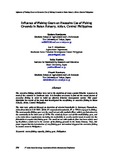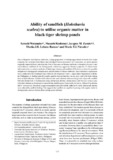Search
Now showing items 1-10 of 28
Recent developments in the study and surveillance of koi herpesvirus (KHV) in Asia
(Fish Health Section, Asian Fisheries Society, 2011)
Koi herpesvirus infection causes significant mortalities in common carp (Cyprinus carpio carpio), koi carp (Cyprinus carpio koi) and ghost carp (common x koi cross, Cyprinus carpio koi). Outbreaks have been reported in ...
Influence of fishing gears on excessive use of fishing grounds in Batan Estuary, Aklan, central Philippines
(Asian Rural Sociology Association, 2010)
The excessive fishing activities have led to the depletion of many coastal fisheries resources in most of the countries in Southeast Asia. It is therefore necessary to find out the causal factors of excessive fishing in ...
Series: Summary of Proceedings No. 1/2013
The Agusan Marsh and the Agusan River Basin: The need for science-based development and management
(PCAARRD-DOST, 2013)
Series: NOAA technical memorandum; NMFS-F/SPO-168
Development of integrated multi-trophic aquaculture using sea cucumber
(United States Department of Commerce, National Oceanic and Atmospheric Administration, National Marine Fisheries Service, 2017)
In Southeast Asian countries, aquaculture production continues to increase. Environmental deterioration associated with water and sediment eutrophication by aquaculture effluent has been problematic, sometimes resulting ...
Morphological development and survival of Philippine silver therapon larvae, Leiopotherapon plumbeus (Kner, 1864) reared under different feeding schemes
(De La Salle University, 2016)
Philippine silver therapon, Leiopotherapon plumbeus, locally known as ayungin, is an endemic fish species in the country. The demand for silver therapon remained high despite the decline of its population and commercial ...
Using mangroves for aquaculture - Why should we?
(Western Indian Ocean Marine Science Association (WIOMSA), 2011)
Although brackishwater ponds have been a major factor in mangrove loss in Southeast Asia where aquaculture is centuries-old, the “No Touch option” for mangroves is a luxury that most countries in the region cannot afford. ...
Digestibility and effective level of meat and bone meal in formulated diet for milkfish, Chanos chanos Forsskal, grown in fresh and seawater
(Masyarakat Akuakultur Indonesia (MAI), 2015)
The efficient level of MBM for good growth and survival of milkfish, Chanos chanos Forsskal, without histological changes in tissues (liver, intestine, muscle, kidney and brain) was determined in both freshwater (FW) and ...
Expressions of molt-inhibiting hormone (MIH) and extracellular signal-regulated kinase (ERK) during the molting stages of the giant mud crab, Scylla serrata
(De La Salle University, 2017)
Survival and growth of mud crabs and any other crustaceans depend on molting. Molting is influenced by several hormones, two of which are Molt-Inhibiting Hormone {MIH} and a molt promoting hormone, the Extracellular ...
Series: ACIAR Proceedings; No. 136
Ability of sandfish (Holothuria scabra) to utilise organic matter in black tiger shrimp ponds
(Australian Centre for International Agricultural Research, 2012)
Due to frequent viral disease outbreaks, a large proportion of shrimp aquaculture in South-East Asian countries has switched from black tiger shrimp (Penaeus monodon) to P. vannamei, an exotic species originally imported ...
Series: ACIAR Proceedings; No. 136
Overview of sea cucumber aquaculture and sea-ranching research in the South-East Asian region
(Australian Centre for International Agricultural Research, 2012)
South-East Asia has traditionally been the global centre of production of tropical sea cucumbers for Chinese markets. Early research into culture methods took place outside this region, notably in India, the Pacific region ...










